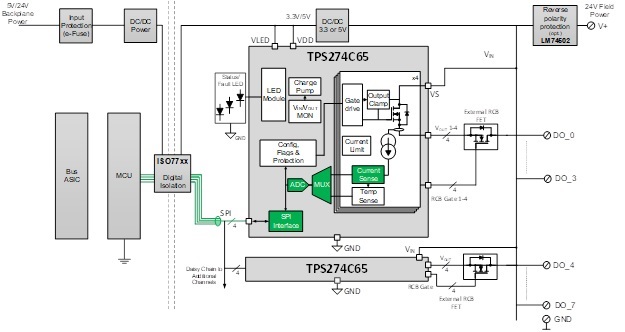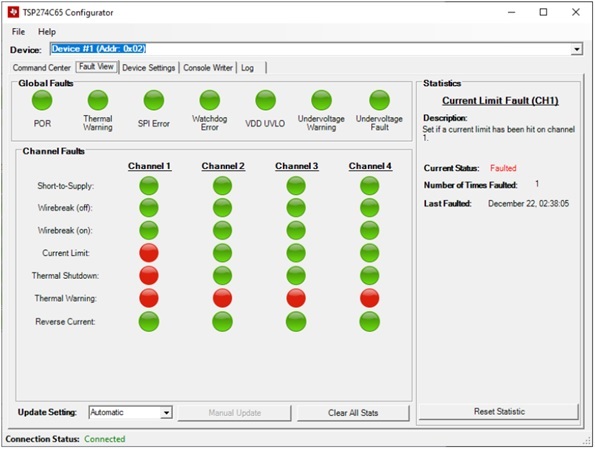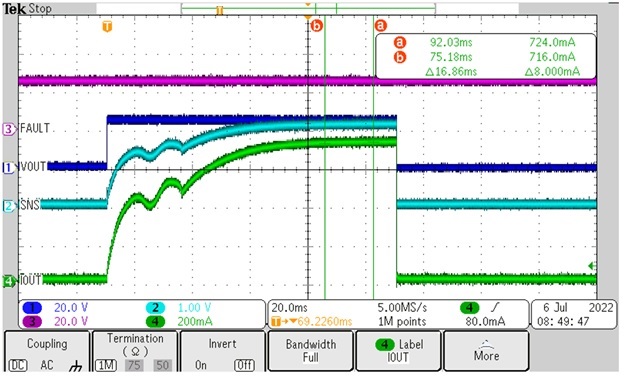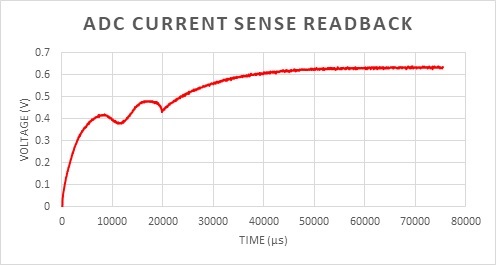-
Decrease factory downtime in 24-VDC power distribution with advanced load diagnostics
Decrease factory downtime in 24-VDC power distribution with advanced load diagnostics
Paul Kundmueller
In Industry 4.0, the amount of diagnostic data is growing each year, enabling systems to become smarter, remain online longer and – in the end – increase productivity. In programmable logic controller (PLC) systems, robotics and machine tools, one area that is still traditionally lacking diagnostic data is 24-VDC power, which distributes power to different control systems in a factory.
If something goes wrong with 24-VDC power distribution, the lack of load diagnostic data often requires long debugging checklists full of rudimentary steps (such as “Is the power-good LED green or red?”) or intrusive investigations such as module disassembly, which increases downtime and decreases productivity.
Current sensing is a load diagnostic that when added to a 24-VDC power distribution network improves data collection, making it possible to diagnose overload currents, wire breaks and aging mechanical systems, or identify whether a load turned on correctly or not all.
The ability to sense current with an analog-to-digital converter (ADC) and a current-sense amplifier or high-side switch with integrated current monitoring has always been available. However, given factors such as isolation barriers, the limited number of ADC channels, or the routing of ADC channels, the implementation of current sensing can be expensive or difficult.
One way to add current sensing while not overcomplicating a system would be to use a high-side switch with an integrated ADC. The TPS274C65 packs four 65-mΩ high-side switches into a 6-mm-by-6-mm quad flat no-lead package which leads to a reduction in power dissipation of 38% versus similar industrial high-side switches available in the market. The high-side switch channels and ADC are controllable and configurable through Serial Protocol Interface communication. Integrating the current-sense circuitry and ADC in the TPS274C65 enables it to transfer current-sense data over isolation barriers in digital output modules and reduce the routing of ADC channels, since all of the routing occurs inside the chip. Additionally, the device can also sense the temperature of the internal metal-oxide semiconductor field-effect transistors (MOSFETs) and sense voltage on the input and outputs.
Figure 1 is a block diagram illustrating how the TPS274C65 in a digital output module helps increase the amount of data sent back to the PLC controller over the isolation barrier.
 Figure 1 The TPS274C65 in a digital
output module application
Figure 1 The TPS274C65 in a digital
output module applicationLet’s focus now on the TPS274C65’s use in factory applications such digital outputs; remote input/output (I/O) modules; and larger systems such as robots, computer numerical control machines and multicarrier systems.
Using current sensing to shorten debugging checklists
As I mentioned above, without diagnostic data, repairing systems can lead to long debugging checklists or intrusive investigations such as module disassembly. This can be problematic for complex systems such as robots and machine tools. The integrated ADC in the TPS274C65 enables both on-site and remote checks to determine the correct distribution of power to the different sensors, relays and subsystems, which helps eliminate potential root causes and enables users to identify problems more quickly. Such monitoring also lets users know if a subsystem is not working properly – for example, they could bring a spare part if on-site debugging is required.
Figure 2 shows what a command center for a power-distribution network could look like in a digital output, remote I/O, machine or robot application. This level of detail could help provide more information to help find the root cause of an offline system.
 Figure 2 The TPS274C65USB evaluation module GUI
Figure 2 The TPS274C65USB evaluation module GUIUsing current sensing to provide predictive maintenance and predictive resolution
To take it one step further, having diagnostic data that shows how a system had been operating before it failed enables the establishment of a predictive resolution procedure to prevent future machines from failing in the same way. For instance, using current sensing to determine whether a small motor or actuator is drawing more current to perform the same function could mean that it is aging, close to failure, or that some mechanism might need servicing.
The integrated ADC in the TPS274C65 enables the collection of this data to perform predictive maintenance and predictive resolution, thus making sure that downtime is planned rather than unplanned. For example, capturing the load-current profile of a solenoid valve could detect whether the valve performance is changing over time. Does the valve have any additional life, or does it need replacing?
Figure 3 shows how the integrated ADC senses the load-current profile of the solenoid valve.

(a)

(b)
Figure 3 Example of the current-sensing capability of the TPS274C65: a scope shot showing the load-current profile of a solenoid valve (a); a readout from the TPS274C65 ADC of the load-current profile of a solenoid valve (b)Conclusion
The TPS274C65’s current-sensing capabilities in factory automation systems decrease downtime and increase productivity. In the end, it will really come down to how you can use this tool in your toolbox to make power distribution smarter.
Additional resources
- To start evaluating the performance of the TPS274C65, check out the TPS274C65 evaluation module for quad-channel 65-mΩ ON-resistance high-side switch.
- To learn more about TI’s growing portfolio of high-side switches, see the high-side switches portal page.
IMPORTANT NOTICE AND DISCLAIMER
TI PROVIDES TECHNICAL AND RELIABILITY DATA (INCLUDING DATASHEETS), DESIGN RESOURCES (INCLUDING REFERENCE DESIGNS), APPLICATION OR OTHER DESIGN ADVICE, WEB TOOLS, SAFETY INFORMATION, AND OTHER RESOURCES “AS IS” AND WITH ALL FAULTS, AND DISCLAIMS ALL WARRANTIES, EXPRESS AND IMPLIED, INCLUDING WITHOUT LIMITATION ANY IMPLIED WARRANTIES OF MERCHANTABILITY, FITNESS FOR A PARTICULAR PURPOSE OR NON-INFRINGEMENT OF THIRD PARTY INTELLECTUAL PROPERTY RIGHTS.
These resources are intended for skilled developers designing with TI products. You are solely responsible for (1) selecting the appropriate TI products for your application, (2) designing, validating and testing your application, and (3) ensuring your application meets applicable standards, and any other safety, security, or other requirements. These resources are subject to change without notice. TI grants you permission to use these resources only for development of an application that uses the TI products described in the resource. Other reproduction and display of these resources is prohibited. No license is granted to any other TI intellectual property right or to any third party intellectual property right. TI disclaims responsibility for, and you will fully indemnify TI and its representatives against, any claims, damages, costs, losses, and liabilities arising out of your use of these resources.
TI’s products are provided subject to TI’s Terms of Sale (www.ti.com/legal/termsofsale.html) or other applicable terms available either on ti.com or provided in conjunction with such TI products. TI’s provision of these resources does not expand or otherwise alter TI’s applicable warranties or warranty disclaimers for TI products.
Mailing Address: Texas Instruments, Post Office Box 655303, Dallas, Texas 75265
Copyright © 2023, Texas Instruments Incorporated